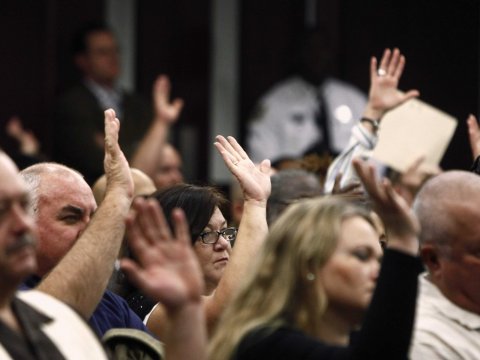Source of article Jury Research Blog.
March 23, 2017

In the first two tips in our series, I focused on encouraging attorneys to treat voir dire as a conversation with jurors (Tip 1) and to use techniques that help jurors become comfortable with speaking at the beginning of voir dire (Tip 2). But much, if not most, of voir dire questioning relies on having jurors raise their hands in response to your questions. Such hand-raising may be an end in itself or, as in many cases, is the gateway for follow-up individual questioning. Whether it is questioning in smaller groups (e.g., 12-14 potential jurors or less) or much larger groups (20-30 or even 100 potential jurors), encouraging jurors to participate by raising their hands is of primary importance. While attorneys rely on jurors to raise their hands, jurors are often reluctant to do so. Using techniques to encourage jurors to raise their hands at the beginning of voir dire (e.g., initial hand-raising) will help jurors feel more comfortable, fostering initial participation and setting the stage for greater participation as voir dire continues. (Click here to see a short video for this tip.)
Initial Hand-Raising
Just as we considered “breaking the ice” with jurors at the start of voir dire by asking all jurors to participate using the initial background summary technique (five initial questions) in Tip 2, we need to break the initial reluctance of jurors to raise their hands as well. There are two basic approaches to accomplishing this task. The goal of both approaches is to have everyone raise their hands, but each relies on different mechanisms to achieve this goal. The first approach relies on peer support, while the second approach capitalizes on the qualifications that all jurors share in being in the jury venire.
Lend Your Fellow Jurors a Hand (peer support)
The first approach uses a peer support technique to enroll all jurors in a hand-raising exercise. This approach takes a comfortable, conversational introduction or what might be termed as “folksy” approach to the task. It simply encourages all jurors to raise their hands in support of each other. Consider the following example:
“Now, many of my questions will require you to answer by raising your hands. Over the years in talking with jurors about this process, many jurors have told me that a big hurdle they faced was raising their hands for the first time. After they had done so, they felt more comfortable in raising their hands to future questions. So, let’s do your fellow jurors a favor by everyone raising their hands (including me).”
Of course, you may be asking questions after the opposing party has asked its voir dire questions. You may feel that the peer support approach is not an option. But it is and should be used when questioning by your opponent has produced minimal participation or involvement. Consider the following example:
“I will be asking a number of questions that will require you to raise your hands to answer. Now, I have noticed that a number of you have not had a chance to participate so far. Over the years in talking with jurors about this process, many jurors have told me that a big hurdle they faced was raising their hands for the first time. After they had done so, they felt more comfortable in raising their hands to future questions. So, let’s do your fellow jurors a favor by everyone raising their hands (including me).”
The peer support technique oftentimes yields a variety of reactions from jurors. Many jurors respond by smiling or chuckling and even turning to others to see if they raised their hands. Other jurors have no reaction but simply comply. Of course, there are some jurors who may respond in a guarded or skeptical manner. And that is good also. It can help to identify potential jurors who are less receptive to you, which is valuable information as you proceed through voir dire and jury selection.
Hey, We’re All Qualified!
The second approach addresses the task of having all jurors raise their hands by asking a question for which all jurors should raise their hands. The easiest way of ensuring full participation is to ask a question that is based on the qualifications for jury service in the trial jurisdiction. Asking one of the following questions could easily fit into voir dire, no matter if you are asking questions before or after your opposing party.
How many of you have lived in (this city/county/area) for the last (x months)? (The information in the parentheses represents statutory requirements.)
How many of you are registered voters? (In some federal courts, voter registration is a necessary condition of service.)
How many of you are U.S. citizens? (Fun fact: I had one case where a potential juror who was not a U.S. citizen made it into the jury pool.)
While we are interested in the answer (since it is based on the qualifications for jury service), the primary focus of the approach is to have jurors engage in the behavior of raising their hands. By doing so, jurors become more comfortable in raising their hands and participating in the voir dire questioning process.
Get Jurors to Participate from the Start: The First Step to Successful Voir Dire
Having full participation from jurors is the key to effective voir dire. Initial full juror participation through their verbal answers (Tip 2) and/or through the raising of their hands (current tip) sets the stage for subsequent voir dire success. As we will see in our next tip, taking advantage of the benefits of open-ended questions is the next step in conducting effective voir dire. But we will cover that later.
We will be covering additional tips in the months to come. Check out our introductory two-minute video, Tip 1, Tip 2, and the video for Tip 3.
For more information on voir dire and jury selection, see Mastering Voir Dire and Jury Selection.
![]()
